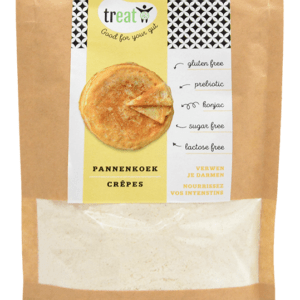Manuka Honey 85+ is a pure honey from the manuka tree that grows in South East Australia, especially in Victoria, New South Wales and the island of Tasmania. And in New Zealand, but mainly on the east coast of the island. Mānuka (comes from the Maori language ‘mānuka’) is the name used in New Zealand. In Australia “tea tree” is used and to a lesser extent in New Zealand. The name came about after James Cook used the leaves in the 18th century to make a ‘tea’ drink. The honey is created when honeybees collect the nectar from the manuka flowers. These flowers are white, sometimes also pink, have a diameter of about 8 to 15 mm, and each flower has five petals. A manuka tree grows to an average height of 2 to 5 meters, but under favorable conditions can even reach a height of 15 m.
The honey has its own, unique, strong taste and the color is darker than normal honeys. The special thing about Mānuka honey is its antifungal and antibacterial effect, which are expressed in a UMF (Unique Mānuka Factor) value (see below) or MGO or methylglyoxal content. The higher the UMF or MGO content, the more powerful the honey. At Levensstroom you can choose from Manuka honey with an MGO of 85+ for daily use in the kitchen and the more powerful manuka honey with an MGO of 514+ with stronger antibacterial properties.
Mainly Manuka honey from the South East of New Zealand is known for its high UMF. Other regions in New Zealand produce Mānuka with a variable Unique Mānuka Factor.
What makes a honey antibacterial?
There are 3 properties through which a honey can be considered antibacterial.
1. Hydrogen peroxide
- Bees will add the enzyme glucose oxidase to the nectar during the processing process that makes hydrogen peroxide. Hydrogen peroxide, also called oxygenated water, is an inorganic compound of hydrogen and oxygen, with the gross formula H2O2.
- Tip: the enzyme glucose oxidase, and also hydrogen peroxide, are sensitive to light and heat. That is why it is better to never heat your honey above 50°C and always keep it in a dark place.
2. Low Moisture Content
- The amount of water in honey is normally between 15 and 21 percent.
- Due to the interaction of the monosaccharide molecules (the simplest form of sugar, sugar with 1 ring structure such as glucose, fructose and ribose) and the water molecules, only a small amount of water is available for the growth of bacteria.
3. Acidity
- Because honey has a relatively high acidity (pH of 3.2 < X < 4.5), it is an unsuitable environment for bacteria to survive and grow.
- However, there is still a 4th property that determines the antibacterial quality of honey. This fourth component is not found in every honey! This one is:
4. Non-peroxide antibacterial activity
This property can only be found in the Mānuka honey!
Not all Mānuka honey has a high non-peroxide antibacterial activity!
UMF is an international trademark. This means that only owners of a registered license may use the UMF scale. Only those producers and exporters who meet strict standards for the purity and quality of Manuka honey are licensed to use the UMF quality brand. The UMF value is between 0 and 20.
The UMF in Mānuka honey depends on two factors:
1. Purity
The less other nectars added to the honey, the purer it is. For example, the degree of purity can vary between 50% and 100%. The greater the presence of Mānuka nectar in the honey, the higher the Unique Manuka Factor.
2. Geographical Origin
- Mainly the Mānuka honey from the southeast of New Zealand, namely from Victoria, New South Wales and the island of Tasmania, is known for its high Unique Manuka Factor. Other places in New Zealand produce Mānuka with a variable UMF, or even Mānuka honey where no non-peroxide antibacterial activity is found.
- It is also possible to use the amount of Methylglyoxal (MGO) to determine the purity. The amount ranges between 30 mg/kg and 900 mg/kg. As with UMF, the following also applies here: the higher the value, the purer the honey.
- MGO and UMF are 2 different values. How do you compare them then? Well, an MGO content of 85 mg/kg corresponds to UMF 5. And, for example, UMF 10 corresponds to an MGO value of 263 mg/kg. For UMF 15 the methylglyoxal content already rises to 514 mg/kg. You will also find the Manuka honey 514+ with us.
What should you pay attention to if you want to buy Manuka honey?
- Avoid packaging where no reference to UMF or MGO is made. If a label says “Mānuka honey 10+”, it could be a TAA or total activity of 10+, including hydrogen peroxide activity. The hydrogen peroxide activity occurs in all types of honey and by adding this together with the non-peroxide activity (Total Activity or TA) you get a higher value that can be misleading on the label. This gives the impression that it is a very pure honey. But you are actually being misled.
- Look for honey with UMF of at least 4.5 or 5. From then on we talk about an active Mānuka honey. A UMF < 4 is negligible.
- If MGO is used instead of UMF, watch out for an MGO value of at least 85+. An MGO value of about 85 mg/kg is comparable to UMF 5.
- Do you see Mānuka honey for sale somewhere at a dirt cheap price? Then you may also be dealing with a spot product.









Reviews
There are no reviews yet.